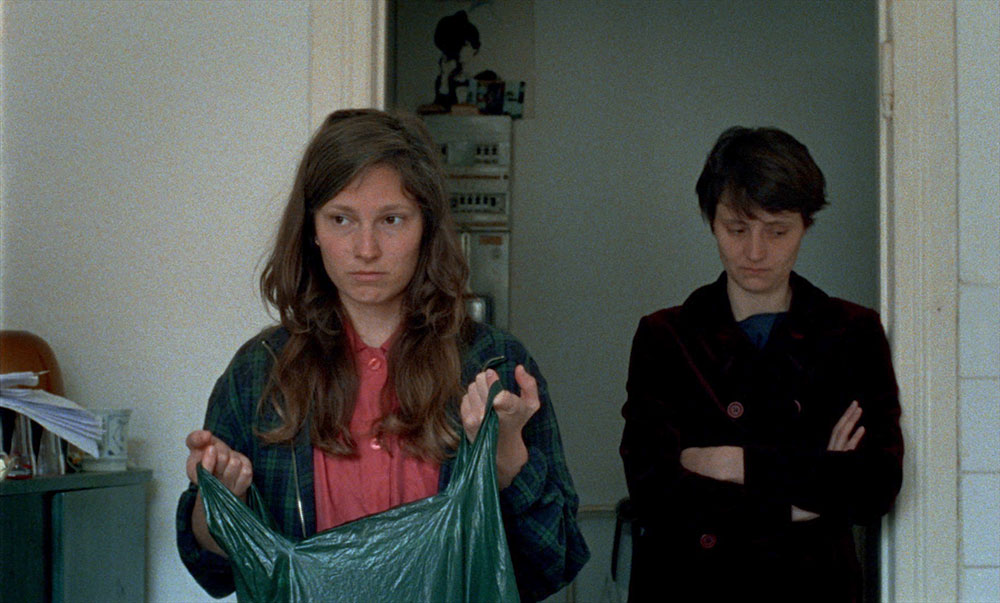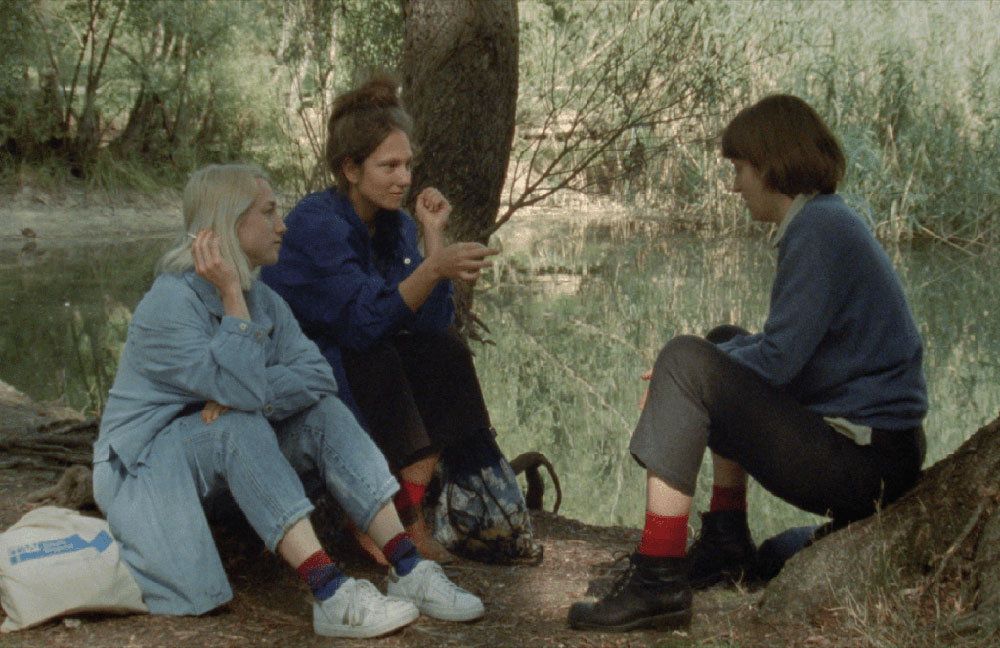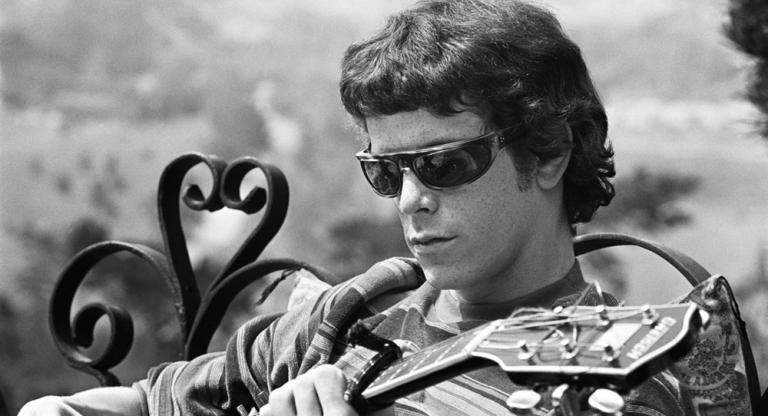Shot on 16mm and clocking in at 61 minutes, Outside Noise (2021) is the third and latest feature by Ted Fendt. Like his previous features, Short Stay (2016) and Classical Period (2018), it’s more concerned with details of character and place than with plot or ideas, content with building its own rhythm. Difficult to describe in its sense of fleeting, unimportant detail, yet defined by an innate simplicity and stylistic naturalism, Outside Noise spends its brief runtime following Daniela (Daniela Zahlner), a young insomniac, first as she visits her friend Mia (Mia Sellman) in Berlin and later as Mia comes to visit her in Vienna, bringing along Natascha (Natascha Manthe). Fendt imbues the film with a quiet energy akin to Daniela’s late-night state of semi-wakefulness, letting its subtle textures and characters wash over you without making demands of how you should feel or think.
Joshua Bogatin: We could start by talking about walking. I noticed that in your films there’s always a lot of walking—
Ted Fendt: As opposed to driving or riding a bike?
JB: Well, it’s a lot of walking without necessarily going anywhere. You seem to capture walking as a sort of in-between moment.
TF: I like showing characters walking as a way to show places. It’s a way to show certain areas of the city that I wanted to show, to give a sense of the atmosphere of a neighborhood. In Outside Noise, when Daniela is walking around Berlin, she’s walking around places where I had lived for a few months and had also explored on foot. It was also a way of showing a person not having anything to do and getting out of the house just to sort of walk around.
But I think the walking has many different purposes. I’m thinking back to a short I made, Travel Plans [2013], which had a couple shots of the characters walking down the streets in my hometown. I just liked the idea of showing these suburban American streets, in a way. You could of course show that without the person walking down the street, but obviously the landscape has a different quality when there’s a person there.
JB: For me, the rhythm of Outside Noise and of your other films can also feel like a stroll to no place in particular. You sort of move around with the characters, encountering various things along the way. Maybe there’s some excitement or a little bit of drama, but it never feels headed in a particular direction.
TF: Well, the film is dealing with people [who] don’t necessarily have a clear goal, [who] are not really sure what they want to do and are not necessarily satisfied with where they are. They need some kind of change, but they’re not at the point where they can articulate that yet. I realized later that this kind of relates to what I was feeling around like 2016, 2017, 2018. I was in New York but beginning to feel unhappy there and wanted to change somehow, but didn’t know how to even express that. Then I found myself in Berlin and Vienna, so there’s [an] element of biography in there in a way.
JB: How did you start to develop these feelings and ideas into a script? Your films can feel more like portraiture than drama at times, so I’ve been curious as to how you give a project like Outside Noise its form and shape?
TF: Very associatively. Initially, it was gonna be just a short film where Mia would be visited by Daniela, but then Daniela came to New York for a vacation. And I said, “It’d be funny to shoot a test when you’re here, and maybe it could go in the movie.” But, of course, if it went in the movie it would be that her character’s in New York, which makes it a completely different story.
I think the film has this presentational quality to the way the scenes are shot because I was consciously trying to make this relationship between the viewer and the images really direct, without any intermediary of fiction. Like if you shoot a movie in Vancouver but it’s set in New York, you’re looking at a shot of the street of Vancouver, but in your mind you’re saying it’s New York. That’s like a filter, and I wanted something different. I wanted to allow a kind of immediacy to work.
With the very first shot of Mia in the film, where she’s lying on the bed, the character hasn’t been introduced yet, so she’s just a person on a bed, and there’s maybe the chance for the audience to have this direct experience of this person. I’m trying to get at a good, direct experience of places and people that you would only have if you went there, if you were face to face with this person, without allowing the fiction to be so much of a barrier.

JB: How would that sense of immediacy work in relation to your use of voiceover? I know that it’s the first time you used voiceover, and I was wondering how—
TF: That might contradict what I just said? [laughs] The decision to use voiceover was very spontaneous. I haven’t done it before, but it’s not because I was opposed to it. I just hadn’t had the occasion to do it or had an idea that seemed appropriate. It’s like music. I have never put music in my films, but it’s not because I’m opposed to music. It has just never felt appropriate. I liked the idea of putting voiceover in because it kind of gives you some information about her state of mind, but doesn’t at the same time because it doesn’t elaborate on it.
And of course it makes it absolutely fictional. So this effect I had, of unfiltered immediacy, is probably most prominent before the voiceover kicks in. But at the same time, there are films I love that have included voiceover—either an internal voice over of the film, or the filmmaker, or the character—which doesn’t completely upset this sense of immediacy that I like. It’s a kind of voiceover that’s running parallel to the images, obviously affecting how you see the things, but still leaving you with some freedom.
JB: In general, what is it about this sense of immediacy that appeals to you?
TF: I just think it’s one of the most unique things about film. There’s a quote I always come back to from Tag Gallagher’s book about Roberto Rossellini. The quote is about cinema giving you this almost direct experience of a person that you don’t have in literature and you don’t have in other arts. It’s this heightened quality of whatever you’re seeing. Like a picture, it has qualities of indexicality which are intensified by virtue of being enlarged, by being projected, by the quality of the colors, and just by being in the environment of the cinema with an audience concentrated on it. It’s like a phantom, but it also has this very direct quality. I was very into that idea in shooting this film and my last film, Classical Period.
JB: But then why work with fiction in the first place?
TF: Because I think you can’t avoid fiction. Frederick Wiseman called his films “reality fictions,” because they’re edited fictions. They’re not a one-to-one representation of “real life.” You can choose to be more or less fictional, either because you do or do not stage the things happening in front of the camera, but I think anything in film can be considered fictional.
From the beginning, I’ve always had the need to work with some kind of narrative structure, as opposed to just collecting images and then figuring out some connections between them later. It also has to do with stuff I was seeing in my twenties when I started making films. The films that I was really inspired by were these American independent films which were using narrative, like Killer of Sheep [1978] or Wanda [1970], that were getting re-released at that time. It was a really important thing to see people making a film with very little means and non-professional actors, but doing it with narrative. I got more into non-narrative films in the following years, but at that point I had already gotten into this way of making films with some kind of a narrative. But obviously not much. The films I make don’t have enough narrative to call themselves narrative films, but they have too much narrative for people that like more experimental films, so there’s a weird limbo.
JB: I also wanted to also ask you about your camera language—your use of movement and framing. In Outside Noise the camera sometimes seems to move beyond how the characters and action might dictate the camera placement as if it had a voice or a mind of its own. For example when Daniela is walking with her friend Katharina the camera moves past them to capture the park they’re walking in, or later, when they’re doing the Charleston, the camera goes to their feet before they even start talking about dancing.
TF: With Katharina it had to do with rhythm. I was using the pan a little bit like a transition. It’s a formal movement, but it’s also just showing the landscape. The hill they’re on is one of the highest points in Vienna, and I wanted to show that they’re on this high park. I like when camera movements are not motivated by the actors, so sometimes, if it feels right, I just have the idea to do it and then we do it. I just think that when I watch that later it will be exciting, the camera just suddenly moving. But sometimes it was just practical things that determined how we shot. A lot of it was dictated by not having a budget to work with, and having to work with the locations as they are, doing very minimal set design.
JB: You’ve said before that you wouldn’t want more money for your films. Do you find that having a small budget is a productive constraint?
TF: No, I would like more money to pay the people in my films more. That would be nice. But I don’t have the aspiration to make bigger films, or use this film as a stepping stone to make a bigger budget film that I’ve secretly been wanting to make.
I don’t know. It just is what it is. Everything I think of, the solutions we find have to be found within what we have available to us. There are so many things that are hard to do without much money. Like the party scene, we didn’t have money to cast that, or the time to find the right people for the party. So it became difficult to shoot with extras, and find an apartment, and then not have time to set design. Of course there’s also a certain aesthetic.

JB: It also seems like it contributes to that idea you were talking about earlier, of wanting to shoot things as they are. If you don’t have money, you don’t have money to change things.
TF: Yeah, because there’s also this tension, that is always there in film, between using the camera to explore the world out there, just reacting to that as a filmmaker, and trying to realize your intentions in front of the camera. I don’t want to, in the context of this interview, develop a critique of highly staged, highly designed films. I don’t necessarily think I would stand by such a critique, because for example, I like Hollywood musicals, where everything is designed and staged and choreographed. But there’s this other filmmaking which I’m more interested in, which is about being out in the world with the camera and reacting to it. And the actors enter into this too because I’m reacting with them as they’re reacting to the environment. I try to negotiate working closely with the camera person without overly staging everything [from] behind the camera. There’s still life happening and the camera is capturing that. I don’t want to intervene too much. Even though that causes tricky situations, like filming in the streets and having people look into the camera, or shooting the dialogue outside and there are loud cars.
JB: What appeals to you about working with your friends as performers?
TF: In the past, it was more a desire to work closely with people, almost at an ethnographic level. Then, as I’ve worked with more people, different people, the characters have become more and more fictional and have had increasingly less to do with the actual person. In Outside Noise the character’s core comes from the actor, like Daniela’s insomnia or Mia’s masters degree. In Classical Period, Cal had this capacity to talk for ten minutes straight about a topic that he’s interested in, and so I thought, What if we make that the only character trait, and push that as far as possible?
I’m not very interested in working with whatever the skill set is that trained actors would bring. It would feel like something that I’d have to work against. And whatever would come out of that tension isn't necessarily what I’m interested in. Obviously I could make my life easier if I sought out—not necessarily good, but known—TV actors, whose name is appealing on a poster. But I’m interested in the appeal of the face that hasn’t been seen in other films before, of new faces. I’d rather cast someone on the street who has a much more fascinating face and life history than someone who lives in LA and desperately needs to be in a role in order to pay the rent.
JB: I was wondering if you could talk about the title a little bit. I've heard that it came from a quote by Levinas.
TF: It was sort of associative as well. I had this idea of insomnia as a topic in the back of my head, and I was listening to the French radio when they mentioned philosophers who had written about insomnia. Levinas wrote about insomnia in his first book, and the way he describes it is really evocative.
I think the title gives you some kind of context without being super specific. It leaves you room for interpretation, to apply it in different ways depending on how you’ve watched the film and how you relate to the characters. In general I don’t like orientation so much in films. A title is obviously gonna give you some orientation, but in this case it’s kind of nice it’s not giving too much.In my mind it was very specific to insomnia, to the sounds you hear in the night when you can’t sleep. Levinas calls it the “sound of existence.”
Outside Noise screens March 25–31 at Anthology Film Archives.




